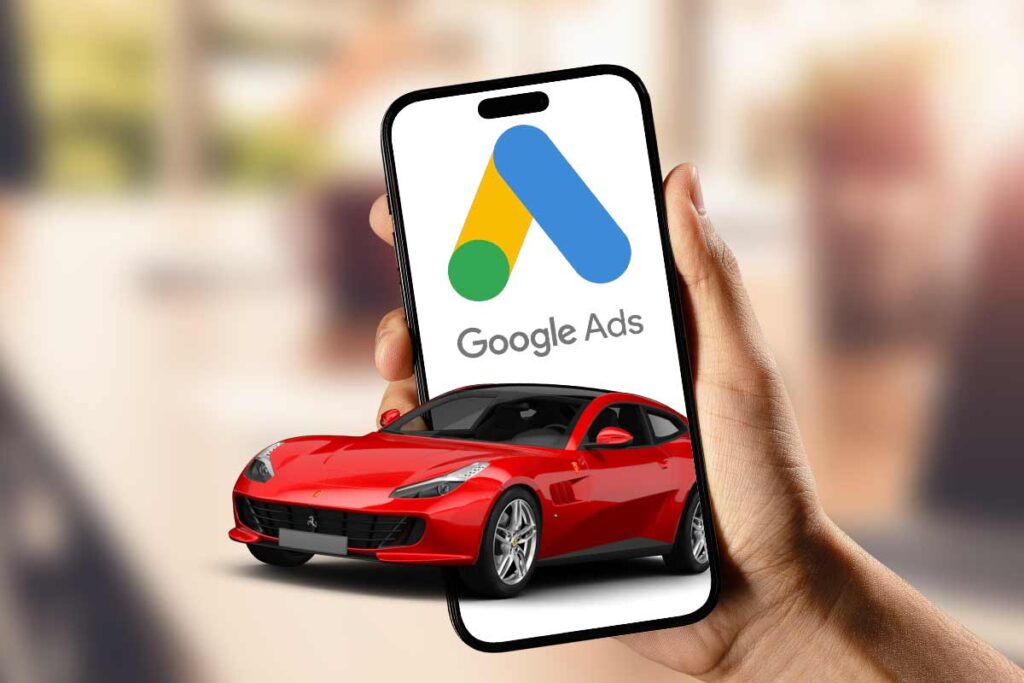Over the past few years, I’ve had numerous conversations about Vehicle Listing Ads (VLAs), and one recurring theme I have noticed is the widespread misunderstanding among decision-makers about how these ads work. Understanding how these ads work is key to maximizing their effectiveness and ensuring they achieve their goals.
In this post, I’ll highlight some common issues I’ve noticed and share a fresh perspective on the correct foundation for evaluating VLA performance and the most effective way to go about it to ensure you get true value at your current dealership.
Understanding the True Purpose of VLAs
Vehicle Listing Ads are a great exposure tool and, when properly set up, can be very powerful for boosting exposure. However, like any marketing strategy, they have a specific role. Dealers United states, “Google Vehicle Listing Ads (Google VLAs) are an automotive-specific solution for dealerships to showcase their inventory at the right moment in the buyer’s journey on the biggest search engine.”
Google Vehicle Ads are delivered via Performance Max campaigns as of 2023. This significant change has further amplified the potential of VLAs by integrating Google’s advanced machine learning and automation directly into dealership advertising strategies. Performance Max utilizes audience signals, real-time data, and predictive analytics to serve highly relevant ads across multiple Google channels, helping dealers reach qualified shoppers at precisely the right moments. Understanding how to effectively leverage Performance Max’s capabilities is now essential for maximizing the visibility and conversion potential of your Vehicle Listing Ads.
Using a one-size-fits-all strategy can frustrate you when trying to interpret performance reports and tie them directly to sales results. You have to align your VLA with your dealership to ensure that the specific metrics align directly with actual sales at your store.
The Problem with a One-Size-Fits-All Strategy
As Outbrain points out, “The era of ‘one-size-fits-all’ advertising is on the way out, and in its place, a sleek, tailor-made strategy is coming to the forefront.” This simply shows the importance of creating customized advertising strategies that align with your dealership’s unique goals and audience behaviors. Adopting a one-size-fits-all approach can lead to confusion when interpreting performance reports and assessing their impact on actual sales at your store, which can actually defeat the purpose of the VLA.
Let me ask you this: Would you rather pay $0.40 per click for thousands of clicks with little to no engagement or $1.50 per click for a few hundred clicks that lead to more conversions, such as form submissions and phone calls?
The answer is obvious. Yet, many VLA campaigns show high click volumes but poor conversion performance. Take a look at this comparison:
Here we have a campaign that looks, from a click level, very effective
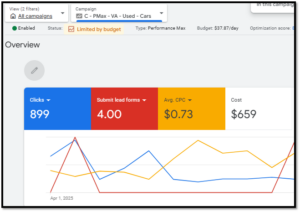
The average CPC is $0.73 cents, which is decent for clicks. But look at that submitted lead form number—four conversions!
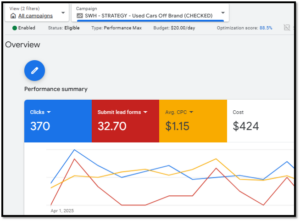
In this example, although we’re seeing fewer clicks and a higher cost per click (CPC), the campaign generates 8 times more of the actions we want from our advertising efforts.
The goal of your website traffic should be to drive meaningful actions that lead to sales—shouldn’t it? So, what’s the real value of high click volume if none of those visitors are taking steps that move them closer to purchasing a vehicle? You might end up with impressive-looking reports full of clicks, yet still question why sales haven’t increased.
You might wonder why this disconnect happened. There are several potential causes, but poor segmentation is the most common issue we see with Vehicle Listing Ads (VLAs).
For VLAs to be truly effective, you must run multiple segmented campaigns. Without this structure, your ads lack the focus needed to reach the right audience with the right message to drive the results that matter.
Consider this:
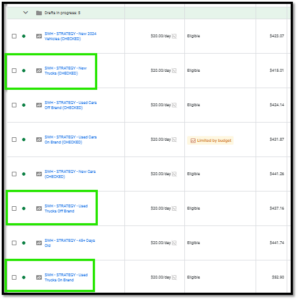
Carefully analyze your inventory, and it is clear that it is not just made up of trucks. You have new, used, and even used trucks outside your primary brand. So why would you group all your used vehicles into one ad campaign or lump everything into a single “used inventory” VLA?
Have you ever tried searching for “used trucks,” but what appears in the results are SUVs or sedans? The simple reason for such a mismatch is poor segmentation, which simply means that your ad spend was wasted.
This is because customers looking for a truck who click on a misaligned ad have a low tendency to be converted because they are already frustrated that they aren’t seeing the result of what they searched for. Multiply that by hundreds or thousands of misplaced clicks, and you can see the cost.
Why Segmentation Matters
A segmented VLA strategy gives you control over key factors such as:
- Location targeting
- Budget allocation
- Audience refinement
- Brand exclusions
Proper segmentation is important because it improves campaign clarity and ensures your ads are aligned with the specific goals of each vehicle type or market region.
As Chris Thompson explains, “Developing targeted marketing strategies requires car dealerships to use segmentation techniques and conduct target audience analysis. By dividing the market into smaller groups of consumers with similar characteristics or needs, dealerships can craft messaging that resonates with each segment’s unique interests and preferences.”
Applying this principle to your VLAs simply means treating each segment strategically, and this leads to:
- More relevant ads
- Improved performance metrics
- Higher-quality leads
Creating Effective VLAs for Car Dealerships: What to Focus On
Vehicle Listing Ads (VLAs) are a powerful tool in today’s digital car sales strategy. They allow dealerships to feature specific vehicle inventory directly before potential customers actively search. But running a VLA campaign is more than just plugging in your inventory and hoping for clicks. It requires a carefully thought-out strategy to ensure your ad spend is actually driving conversions, not just vanity metrics.
There are six key areas that you must get right to make sure your VLAs perform well and work in your favor:
- Segmentation
- Budget Allocation
- Location Targeting
- Signals, Search Terms, and Audience
- Keyword and Brand Exclusions
- Feed and Inventory Accuracy
1. Segmentation: The Cornerstone of Your VLA Strategy
Segmentation is arguably the most important part of a successful VLA campaign. Think about it this way: you have all kinds of inventory segmentation at your dealership. You have new cars and use cars. You also have brand-used and off-brand used cars. You new vs. used cars, certified pre-owned vs. off-brand used trucks, SUVs, and older model-year vehicles.
So why wouldn’t you use the same strategy in your advertising?
Each vehicle category has different buyer intentions and conversion pathways. New vehicles appeal to one type of customer, while older or off-brand used inventory requires a completely different approach. For example, your aged inventory or last year’s models need more visibility and urgency-driven messaging than fast-selling units.
I have often seen dealerships combine new and used campaigns and celebrate the resulting high click volumes. But you have to understand that clicks alone don’t drive revenue. As Forbes highlights, “Focusing on conversion metrics over vanity metrics may be the only true way forward.”
Proper segmentation ensures the right inventory is seen by the right audience. This simply entails maximizing conversions, not just impressions, which is the true goal for every dealership.
2. Budget: Allocating Smartly Based on Demand
Budget mismanagement is another common issue in dealership advertising. One of the main problems with dealership advertising today is that demand fluctuates daily for every vehicle on your lot, and popular units tend to consume a large portion of the budget simply because more people are searching for them. Unfortunately, this leaves your slow movers (which refers to the vehicles that truly need exposure sitting in the shadows.)
VIN IQ’s inventory marketing team states, “Implementing VIN-specific paid campaigns helps move aging inventory by reducing ads for units that already have high visibility.”
You can apply this same principle to your VLA strategy. This helps ensure that popular models don’t siphon off the budget from vehicles that require more promotion.
Let me illustrate this with an example.

We can use Google Trends to compare the search volume for different vehicle makes and models to identify areas where advertising spend may be misallocated. From the illustration above, we can see that for the past 90 days, the national search interest for the Tacoma has been consistently higher than for the Tundra and Camry. If all three models are grouped together in a single campaign, your advertising budget will be disproportionately spent on models that are already performing well rather than supporting those that need more visibility.
By segmenting these models into separate campaigns, you help ensure that your budget is focused where it’s needed most rather than wasted on models already generating interest – Google Trends. Also, it’s important to refine your research by selecting specific geographic areas like your state or city to ensure your strategy aligns with local demand. Note that regional segmentation is highly imperative.
The key point I would love you to take from this section is to understand that not every model should receive the same budget, especially if search interest varies significantly across segments. The budget should be well apportioned.
3. Location: Understanding Geographic Impact
Location targeting is probably the most misunderstood segment of all! You must make sure you understand how this works and impacts your ads. When you properly segment your VLA campaigns, you can set a sensible location.
For example, when running an on-brand campaign, your focus should be on your immediate market. Your ideal market location is ideally within a 20-mile radius of your dealership. This is where you’ll find the highest concentration of in-market buyers already familiar with your brand. In metro areas especially, keep the radius tight, which helps you dominate local search results and protect your Primary Market Area (PMA).
While expanding the radius to 40 or 50 miles may seem like a way to increase reach, it often comes at a cost. Each additional mile dramatically enlarges the target area, diluting your budget and potentially diverting spending from highly qualified shoppers just minutes away. WordStream states, “Radius targeting is deceptively simple… a 10-mile radius covers four times the area of a 5-mile radius,” meaning even small increases can significantly impact your ad spend.
Expanding your radius can be a smart strategy for specific inventory, such as units that have been on the lot for 45+ days or last year’s models that haven’t yet sold. In these cases, widening your reach can help you connect with potential buyers outside your immediate area who may not have initially considered your dealership.
Presence vs. Presence and Interest:
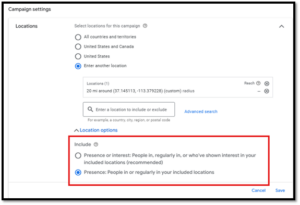
Also, to properly implement location targeting, you must understand the difference between presence or interest and presence. Many dealership VLA campaigns are mistakenly set to “Presence of Interest.” The danger of this is that it leads to significant budget waste by serving ads outside your Primary Market Area (PMA) and, in some cases, even outside your state.
To avoid this, ensure your campaigns are set to “Presence” only. This setting restricts your ads to users who are physically located within your target area. While some agencies default to “Presence or Interest” and attempt to fix the issue with location exclusions, this workaround still allows the budget to leak to users well outside your intended market.
The problem with this is that it isn’t just inefficient; it can affect your entire strategy without obvious warning signs unless you’re very familiar with the inner workings of Google Ads. As the team at Statcounter points out, “The default setting in Google Ads is ‘Presence or Interest,’ which casts a very wide net. With the exception of tourism-related businesses, most advertisers should change this setting to ‘Presence only.’”
Like most strategies, the tight-radius targeting rule has its exceptions. Expanding your geographic reach is wise for harder-to-move units, such as 45+ day inventory or previous model-year vehicles still on your lot. These slower-moving vehicles often need exposure beyond your immediate market to attract new buyers.
In such cases, widening your radius or even layering in “Presence & Interest” targeting can be effective. However, it is crucial to monitor your spending closely and make adjustments based on your current inventory mix.
According to Autotrader’s May 2021 research:
- 46% of car shoppers were willing to buy from a retailer more than 50 miles away,
- 21% would travel up to 100 miles,
- and 16% were willing to go over 200 miles for the right vehicle.
This willingness to travel suggests that expanding your radius for aging inventory can help connect you with serious buyers outside your PMA.
4. Signals, Search Terms, and Audience: Guiding Google’s AI
One of the most overlooked opportunities in VLA campaigns is the use of audience and thematic signals. When you launch a campaign without these, you’re essentially giving Google free rein to target anyone, anywhere, and the danger is that it wastes your spending.

As AdNabu explains, “Audience signals are the lighthouses guiding Google’s AI down the right path.” Signals are like training wheels that help steer Google’s machine learning toward the right audience faster, especially in Performance Max campaigns.
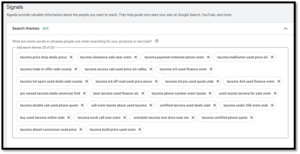
To help Google target the right buyers, you must provide strong audience signals. View signals as imperative training wheels, especially in the early stages of a campaign. Remember, it’s not just about generating clicks; it’s about getting the right clicks.
Unlike fixed search keywords, audience signals and theme-based inputs help guide Google’s machine learning. These signals allow the system to adjust to real-time factors like seasonality, inventory shifts, and special promotions.
The same applies to first-party data. As an industry, we talk a lot about its value, yet many dealerships fail to use the rich insights in their CRM and DMS. That data is a goldmine for improving VLA performance, as it helps ensure your inventory is shown to the most relevant shoppers faster.
By guiding Google’s algorithm to high-value segments earlier, audience signals help to accelerate campaign learning and drive conversions, not just traffic. This is especially critical when using Maximize Conversion Value bidding, where stronger signals lead to better optimization for revenue. As Marin Software notes:
“Adding audience signals to Performance Max campaigns helps guide the algorithm … and speeds up the learning process.”
Even though VLA campaigns are largely automated, supplying accurate signals is important as it helps the system target more relevant buyers from day one. This becomes even more important when switching agencies; each reset restarts the learning phase. As Optmyzr’s State of PPC study explains:
“Audience signals were designed to help teach the algorithm in the early days of the campaign.”
Here’s a simple formula to help build strong audience signals:
Audience Signal = (Inventory Focus × Buyer Intent) + (Brand Familiarity × Market Behavior)
This isn’t a one-size-fits-all solution but a strong starting point. Ask yourself:
- What inventory are you focused on?
- How far along are your shoppers in their buying journey?
- How well-known is your dealership?
- What browsing patterns define your local market?
Even Google supports this approach. Their documentation confirms you can target audiences based on who they are, what they do, what they’re researching, and how they’ve interacted with your business.
These four dimensions map directly to the framework above, giving you confidence that you’re guiding Google’s automation in the right direction from day one.
5. Exclusions: Avoiding Keyword and Brand Waste
When adopting a segmented approach to your Vehicle Listing Ad (VLA) campaigns, I cannot emphasize enough the importance of exclusion, as it matters more than you think.
So, what are brand exclusions?

In simple terms, they are functions that allow you to exclude specific brands directly within your VLA campaigns. This gives you tighter control over what inventory shows up where and ensures your campaign segments don’t overlap or cannibalize each other’s performance.
You have to understand that Google can cross-serve inventory between your segments without exclusions, meaning wrong models or makes can appear in the wrong ad group. That’s how the budget gets burned on clicks that were never meant for that campaign. It’s like running a warehouse without barcodes: everything mixes, and tracking or optimizing performance effectively becomes difficult.
Even Google supports this logic:
“You can use inventory filters to exclude certain products from a Shopping campaign… When you apply an inventory filter to a campaign, only offers that match the filter are advertised.”
(Google Ads documentation)
Let’s break it down with a practical example. Imagine you’re running two VLA campaigns for your dealership:
- On-Brand Campaign – Target only your franchise inventory. If you’re a Mazda dealer, include only Brand = Mazda and exclude all others. That way, searches for Ford or Toyota won’t trigger ads meant for Mazda units.
- Off-Brand Campaign – Promote all non-franchise used inventory. Exclude Mazda here, so shoppers searching for Mazda vehicles aren’t shown unrelated off-brand listings.
This simple segmentation structure ensures each campaign is laser-focused on the right shopper and maximizes the impact of your budget by preventing wasted spend.
You have to understand that Google’s automation is powerful, but it also makes “its own moves,” especially in the early stages of machine learning. You might see odd placements or irrelevant traffic. That’s why it’s vital to steer the system with strong inputs like:
- Brand exclusions
- Audience signals
- Smart campaign segmentation
6. Feed and Inventory Health: The Foundation of Your VLA
Lastly, none of your VLA strategies will be potent if your feed is inaccurate or your inventory isn’t current. You can build a perfectly segmented, well-budgeted campaign, but if your vehicle data is misclassified or incomplete, you’re setting yourself up for wasted ad spend and poor results.
Why Your Feed Is Everything
Google is very clear on this point:
- “Google uses these [feed] details to match a customer’s search to the most relevant cars.” – Google Support
- “When Google evaluates your feed, we exclude individual vehicles that don’t include any of the required fields listed in the feed specification.” – Google Support.
The best way to view your feed is to think of it as a barcode system in a warehouse. Every unit must be accurately labeled make, model, body style, price, and mileage, and irrelevant units must be filtered out. Without this structure, your campaign performance becomes blurred, and meaningful optimization becomes nearly impossible.
Here are a few key things to watch for:
- Misclassified vehicles (e.g., an SUV marked as a sedan)
- Missing attributes (e.g., price or mileage)
- Lack of exclusions (e.g., nobody style filter set)
Don’t “Set It and Forget It.” Even with a strong campaign setup, regular audits are critical. Issues can creep in over time, especially with feed updates, new inventory, or pricing changes, so it is recommended that you check your inventory categories and pricing directly within your VLA asset groups. Make sure everything aligns with how the vehicles appear on your website.
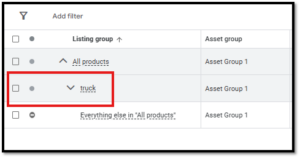
The Danger of Pricing Mismatches
One of the fastest ways to tank your VLA performance is a pricing mismatch between your feed and your website. This is why it is important to ensure that the price on the ads reflects the price on the website.
Let me illustrate this with a real-time example.
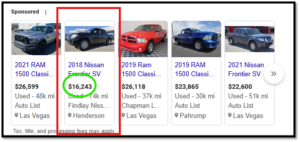
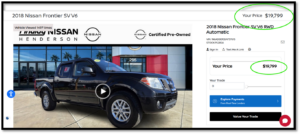
Pricing mismatches are one of the quickest ways to tank a Vehicle Listing Ad. Google bot routinely crawls each vehicle’s landing page and compares the on-page price to the price attribute in your VLA feed. Google Help stated, “When a mismatch is found … the product with the mismatch may be disapproved.”
Also, Google warns that repeated mismatches can lead to account suspension for vehicles that stay active. Google still applies price-quality checks: “We exclude vehicles with prices that fall outside the range of prices that we expect, based on similar vehicles that are available for sale.”
Since dealership pricing can change multiple times per day, Google recommends:
- Scheduling multiple daily feed uploads, or
- Using the Content API to keep prices in sync.
If your VLA ad shows $16,243 but the VDP shows $19,799, shoppers will lose trust, your ad quality score will tank, and visibility will plummet, and this is not something you will love to experience.
Strategy Alone Isn’t Enough—Conversions Must Be Aligned
You can have the right segmentation, brand exclusions, and a polished feed, but none of that matters if your campaigns aren’t aligned with actual dealership goals. Having the right strategy and budget ensures everything works as it should be only one side of the coin. None of these matters unless your ads are set up to convert for the right behaviors.
Most agency reports are full of vanity metrics like impressions, clicks, and CTR, which are great on paper but meaningless if they don’t drive actions that make you money. Alex Thompson puts it best: “While certain ‘vanity metrics’ may look great at first glance, they don’t always connect to real profit.”
This is simply an awakening that you need to optimize your VLA bidding to genuine conversions, not eye-catching numbers that fail to move metal or revenue. It is not about impressing people on paper but making real profit.
Suppose you count a simple Vehicle Detail Page (VDP) view as a conversion. That means every ad click is a success, even though most may never result in a lead. Your reports look fantastic, but the numbers are inflated and don’t reflect real wins like phone calls, form fills, or finance deals. I love how Bernard May says: “Focusing on conversion metrics over vanity metrics may be the only true way forward.”
The Key: Maximize Conversion Value
The key is to maximize your conversion value and drive real success. Your conversion goals in Google Ads are signals to the algorithm. Google can’t optimize toward what matters if they’re missing, misconfigured, or lack value assignments. As stated by Google Help, “Before you can use Maximize conversion value bidding, you’ll need to set up conversion tracking with transaction-specific values.”
Most dealerships already invest in tools to drive high-quality leads but fail to structure their Google Ads goals to reflect this value.
What You Should Do:
- Tag each CTA with a clear, vendor-specific name (e.g., “CarNow – Calculate My Payment”)
- Mark every high-value CTA as “Primary” in your Google Ads setup
- Assign dollar values based on the impact on the dealership
- Highest value = Most profitable action
- Tier down for mid- and low-value CTAs
As Google Help states, “Improve how you measure and optimize your ad campaign’s real impact by assigning values to your conversions … measure at least 2 unique values across at least 2 different actions.”
So if CarNow – Calculate My Payment delivers the most profitable leads, give it the highest value, then step down proportionally for less impactful CTAs. Accurate names, primary status, and tiered dollar values unlock Maximize Conversion Value bidding and make audits faster and cleaner.
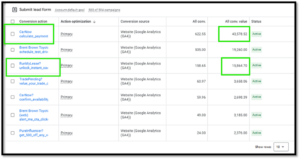
Smart Bidding with Value-Based Goals
Once transaction-specific conversion values are in place, Maximize Conversion Value bidding becomes your secret weapon. This entails setting your conversion goals around true shopping behaviors, lead form submissions, phone calls, and credit apps.
Google’s help center is explicit: “Maximize conversion value bidding will attempt to generate the most conversion value for a given budget. It may bid higher for auctions that would result in greater conversion value than auctions with lower conversion value.”
In value-based bidding experiments, Google notes that “performance against other trailing metrics like CPA and clicks will be incidental and should not be considered.”
Quality Over Quantity: Let Google Work Smarter
With value-based bidding:
- Google uses consumer intent, search behavior, location, time of day, and device data
- To predict which shoppers are most likely to convert
- And bids more efficiently to maximize ROI
It’s about tapping machine learning to find the low-hanging fruit, not just chasing volume. You want quality, not quantity; this bidding strategy is all about efficiencies. Google uses a vast amount of data to predict shopper behaviors, and you want to tap into aspects like consumer intent, previous browsing behavior, search queries, location data, device, and even time of day to ensure you have the best chances of getting the lower-hanging fruit.
Let’s recap how it all ties together:
| Key Area | Goal |
|---|---|
| Audience Signals | Target high-intent, high-fit shoppers |
| Brand Exclusions | Avoid wasted spend on mismatched brands |
| Feed Accuracy | Ensure correct targeting and visibility |
| Conversion Setup | Track real actions, not vanity clicks |
| Value-Based Bidding | Bid smarter for leads that pay |
Conclusion
We’ve covered a lot of ground in this post, and I hope dealerships looking to refine their advertising strategies can find value and actionable insight here. Vehicle Listing Ads (VLAs) are a powerful tool, but their effectiveness hinges on precision, consistency, and a commitment to ongoing management.
Vehicle Listing Ads can be incredibly effective, but only when set up and managed with attention to detail. Every part plays a critical role in performance, from strategic segmentation to intelligent budgeting, precise location targeting, data-driven audience signals, and a clean inventory feed.
Clicks may feel good in the short term, but conversions are the true measure of success. Align your VLAs with that goal, and you’ll see better ROI, faster inventory movement, and more satisfied customers.
Also, note that even with the best-structured campaign, success hinges on what happens after the click. If your landing pages are slow, unresponsive on mobile, or don’t present key vehicle details and CTAs, you lose valuable leads before they engage.
- 95% of car buyers use digital sources, and twice as many begin their search online versus in-person. – Google Dealer Guidebook
- 1 in 3 mobile car shoppers locate or call a dealer directly from their mobile device. – Google Business
- 53% of mobile visitors abandon pages that take more than three seconds to load. – Google Mobile Speed Benchmark
To succeed with VLAs, every piece of the puzzle must align: a clean, regularly updated feed, strategic and value-based bidding, granular tracking of real conversions, not vanity metrics, and a seamless post-click experience that builds trust and encourages action.
If you take one thing away, let it be this: VLAs are not set-it-and-forget-it tools. They require strategy, monitoring, and adjustments to work for your dealership.
Thank you for taking the time to read this. If you need help auditing your VLA campaigns, dialing in your conversion strategy, or optimizing your website experience, I’m always happy to help.


